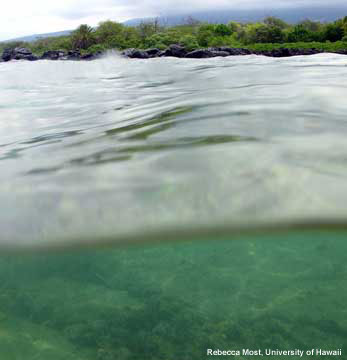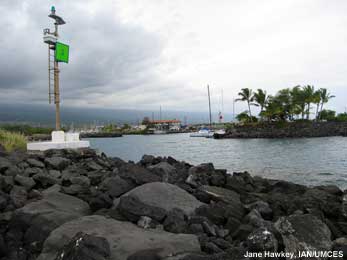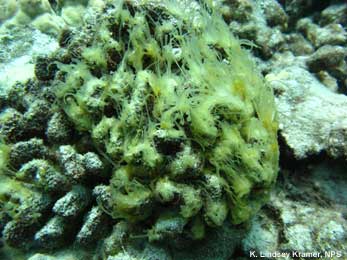Climate change, overfishing, overuse, and urbanization threaten the health of corals
 Unique cultural resources and splendid fish and coral diversity attract many visitors to Kaloko-HonokÅhau National Historical Park. These visitors may observe that these corals are not as healthy as they could be. For example, they might see corals damaged by people stepping on them, or they might observe that the clarity of the water is reduced by nutrients and sediments carried from the land to the reef by runoff. These threats and others such as overfishing and climate change are influencing the coral reef ecosystem. Careful monitoring and management is required to help improve coral health.
Unique cultural resources and splendid fish and coral diversity attract many visitors to Kaloko-HonokÅhau National Historical Park. These visitors may observe that these corals are not as healthy as they could be. For example, they might see corals damaged by people stepping on them, or they might observe that the clarity of the water is reduced by nutrients and sediments carried from the land to the reef by runoff. These threats and others such as overfishing and climate change are influencing the coral reef ecosystem. Careful monitoring and management is required to help improve coral health.![]() Scientists are investigating how groundwater seeps might influence the impacts of climate change in the park
Scientists are investigating how groundwater seeps might influence the impacts of climate change in the park
 Along the coastline of Kaloko-HonokÅhau National Historical Park, groundwater seeps into the ocean and creates brackish, or slightly salty water where unique organisms thrive (NPS 2009). How does groundwater reach the ocean? Well, when it rains, some of the rain is absorbed by the ground and travels through the porous volcanic rock as groundwater. Sometimes this groundwater collects to form underground reservoirs of freshwater, or aquifers, and sometimes the groundwater makes its way to the ocean through pores in the rock.
Along the coastline of Kaloko-HonokÅhau National Historical Park, groundwater seeps into the ocean and creates brackish, or slightly salty water where unique organisms thrive (NPS 2009). How does groundwater reach the ocean? Well, when it rains, some of the rain is absorbed by the ground and travels through the porous volcanic rock as groundwater. Sometimes this groundwater collects to form underground reservoirs of freshwater, or aquifers, and sometimes the groundwater makes its way to the ocean through pores in the rock.When the groundwater and ocean water meet at the coast, the result is cooler water than the surrounding ocean water. This cooler temperature has made scientists curious about how groundwater seeps might affect rising water temperatures due to climate change. Could this cooling effect from groundwater combat rising ocean temperatures due to climate change at this reef? How will groundwater naturally added to the reef influence bleaching or ocean acidification in this area? Currently, no one knows the answers to these questions. However, scientists at Kaloko-HonokÅhau National Historical Park are exploring how groundwater seeps might influence water conditions and coral reef ecosystem in the future. What they discover may help guide the management of coral reefs on HawaiÊ»i and other volcanic islands with groundwater seeps.
![]() Overfishing is putting pressure on coral reefs
Overfishing is putting pressure on coral reefs
Some steps have been taken to counteract overfishing. For example, state law prohibits taking reef fish from Kaloko-HonokÅhau National Historical Park for the aquarium trade (DeVerse et al. 2006). For this reason, visitors may see larger reef fish here than on other coral reefs in the area.
Negative impacts from fishing are worsened by activities in a boat harbor next to the park. Fishing charters leaving from this harbor create noise pollution, increase the number of boat collisions with threatened honu (green sea turtles), and some boats cause physical damage to coral reefs when they run aground (DeVerse et al. 2006). In addition, boat maintenance in the harbor adds pollution, heavy metals, and sewage to the water that reduces water quality and coral health (DeVerse et al. 2006).
![]() Overuse can cause damage to corals
Overuse can cause damage to corals
While exploring coral reefs, it is important to remember to treat all organisms with respect. While visiting coral reefs avoid stepping on coral so they are not damaged. Do not apply sun screen right before going in the water. It will wash off your skin, leave you unprotected, and create a film in the water that hinders corals from absorbing the sunlight they need to live. Leaving trash on the beach or taking pieces of coral home with you also damages coral reefs. Friends of coral reefs leave no trace—after they are gone the reef looks just as it did before their visit.
![]() Urbanization reduces water clarity by adding nutrients and sediments to coral reefs
Urbanization reduces water clarity by adding nutrients and sediments to coral reefs
More developed lands mean that there are more people in the area using sewage systems and fertilizing lawns. These activities increase the nutrients on the ground that are washed onto coral reefs by rain or brought to coral reefs through groundwater (NPS 2009). When nutrients arrive in the coastal waters, they feed algae and allow them to grow rapidly. They can grow so fast that they smother corals. Currently, efforts to reduce nutrients on coral reefs center on preventing them from entering groundwater in the first place (NPS 2009).
Development also increases the demand for freshwater. For example, golf courses draw precious groundwater from aquifers. This means that there is less water available to the organisms in the park. Lower water levels alter park ecosystems and have a greater effect on native plant species that are sensitive to changes in the natural environment.
More ways to explore corals at Kaloko-HonokÅhau National Historical Park
Kaloko-HonokÅhau National Historical Park Website
Coral reefs at Kaloko-HonokÅhau National Historical Park![]()
Blue soft coral![]()
Climate change monitoring briefs
Coral Reefs in U.S. National Parks![]()

